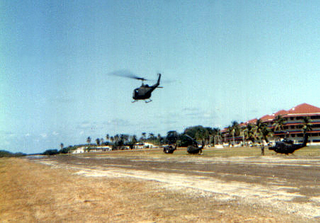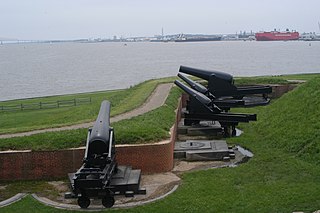
Fort Wadsworth is a former United States military installation on Staten Island in New York City, situated on The Narrows which divide New York Bay into Upper and Lower bays, a natural point for defense of the Upper Bay, Manhattan, and beyond. Prior to its closing in 1994, the fort was claimed to be the longest continuously garrisoned military installation in the United States. It comprises several fortifications, including Fort Tompkins and Battery Weed and was given its present name in 1865 to honor Brigadier General James Wadsworth, who had been killed in the Battle of the Wilderness during the Civil War. Fort Wadsworth is now part of the Staten Island Unit of Gateway National Recreation Area, maintained by the National Park Service.

Taboga Island, also known as the "Island of Flowers", is a volcanic island in the Gulf of Panama. It is a tourist destination, about 20 km (12 mi) from Panama City, Panama.

Fort MacArthur is a former United States Army installation in San Pedro, Los Angeles, California. A small section remains in military use by the United States Air Force as a housing and administrative annex of Los Angeles Air Force Base. The fort is named after Lieutenant General Arthur MacArthur. His son, Douglas MacArthur, would later command American forces in the Pacific during World War II.

The Causeway Islands are four small islands by the Pacific entrance to the Panama Canal. They are linked to the mainland via a causeway, made from rock extracted during the excavations from the Panama Canal. In part the causeway was meant to serve as a breakwater for the entrance.

Fort Sherman is a former United States Army base in Panama, located on Toro Point at the Caribbean (northern) end of the Panama Canal, on the western bank of the Canal directly opposite Colón. It was the primary defensive base for the Caribbean sector of the Canal, and was also the center for US jungle warfare training for some time. Its Pacific-side partner was Fort Amador. Both bases were turned over to Panama in 1999.

Gorgas Hospital was a U.S. Army hospital in Panama City, Panama, named for Army Surgeon General William C. Gorgas (1854–1920).
Albrook Air Force Station is a former United States Air Force facility in Panama. It was closed on 30 September 1997 as a result of the Torrijos-Carter Treaties which specified that United States military facilities in the former Panama Canal Zone be closed and the facilities be turned over to the Panamanian government. It was located on the east side of the Panama Canal just south of Fort Clayton and north of the township of Balboa, Panama. Beginning in January 1999, the air field initiated civilian air service as Albrook "Marcos A. Gelabert" International Airport.

Fort Tilden, also known as Fort Tilden Historic District, is a former United States Army installation on the coast in the New York City borough of Queens. Fort Tilden now forms part of the Gateway National Recreation Area, and is administered by the National Park Service.

The 16 inch gun M1919 (406 mm) was a large coastal artillery piece installed to defend the United States' major seaports between 1920 and 1946. It was operated by the United States Army Coast Artillery Corps. Only a small number were produced and only seven were mounted; in 1922 and 1940 the US Navy surplussed a number of their own 16-inch/50 guns, which were mated to modified M1919 carriages and filled the need for additional weapons.

Fort Funston is a former harbor defense installation located in the southwestern corner of San Francisco. Formerly known as the Lake Merced Military Reservation, the fort is now a protected area within the Golden Gate National Recreation Area (GGNRA) and is used widely as an off-leash dog park. It was named in honor of Frederick N. Funston (1865–1917), a Major General in the United States Army with strong connections to San Francisco, and included several artillery batteries. The fort is located on Skyline Boulevard at John Muir Drive, west of Lake Merced.

Seacoast defense was a major concern for the United States from its independence until World War II. Before airplanes, many of America's enemies could only reach it from the sea, making coastal forts an economical alternative to standing armies or a large navy. Substantial fortifications were built at key locations, especially protecting major harbors. Seacoast defense also included submarine minefields, nets and booms, ships, and, later, airplanes. The U.S. Army Corps of Engineers played the central role in constructing fixed defenses, but all of the armed forces participated.

Fort Kamehameha was a United States Army military base that was the site of several coastal artillery batteries to defend Pearl Harbor starting in 1907 in Honolulu, Hawaii.

The 14-inch M1920 railway gun was the last model railway gun to be deployed by the United States Army. It was an upgrade of the US Navy 14"/50 caliber railway gun. Only four were deployed; two in the Harbor Defenses of Los Angeles and two in the Panama Canal Zone, where they could be shifted between the harbor defenses of Cristobal (Atlantic) or Balboa (Pacific).
Fort Randolph in Panama was a Coast Artillery Corps fort built to defend the northern end of the Panama Canal in conjunction with Fort Sherman.
The 65th Air Defense Artillery was a training regiment in the United States Army. During World War I the unit was a tractor drawn (TD) unit equipped with British BL 9.2 inch Howitzers. When it was reactivated in Panama in 1924 it became an (AA) anti aircraft unit equipped with the 3-inch Gun M1918.

Fort McKinley is a former United States Army coastal defense fort on Great Diamond Island, Maine in Casco Bay, which operated from 1873 to 1947. It was named for President William McKinley. It included a sub-post, Fort Lyon, on Cow Island, just north of Great Diamond Island. Fort Lyon was named for Nathaniel Lyon. Both forts were part of the Coast Defenses of Portland, renamed the Harbor Defenses of Portland in 1925, a command which protected Portland's port and naval anchorage 1895-1950. In 1946 Fort Lyon was closed and turned over to the City of Portland. After Fort McKinley's closure it was transferred to the United States Navy, which sold the site to private interests in 1961. The Fort McKinley Historic District was listed on the National Register of Historic Places in 1985.
Fort William D. Davis is a former U.S. Army fort near Gatun, Panama. It was transferred to Panama in 1995.

Naval Base Panama Canal Zone refers to a number of United States Navy bases used during World War II to both protect the Panama Canal and the key shipping lanes around the Panama Canal Zone. Bases were built and operated on the Atlantic Ocean side and the Pacific Ocean side. The main Naval Base at the Panama Canal was the Naval Station Coco Solo that had been in operation since 1918.













